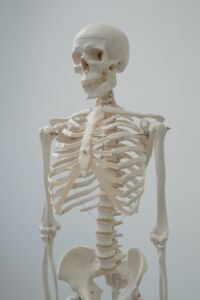The human back is a remarkable piece of mechanical engineering. It absorbs shock, allows for fantastic flexibility, and lets us stand upright. Many structures contribute to the spine’s function, but its curves are one of the most critical parts of its structure. Damage to these curves is a common cause of back pain.
Here’s everything you need to know about your spinal curves and how to protect them.
What are the Spinal Curves?
If you view the human spine from the side, you’ll notice it is shaped like an extended S. There are five spinal curves:
- The cervical curve (neck)
- The thoracic curve (middle back)
- The lumbar curve (lower back)
- The sacral curve (below the lower back)
- The tailbone (or coccyx)
These areas of the back bend in opposite directions. The neck bends inward towards the body; this is called lordosis. The outward curve of the middle back is called kyphosis. Kyphosis and lordosis are also used to describe abnormal curvature of the back (which we will discuss later). Here, they mean the normal inward or outward curve of the spine.
To understand why the spine is shaped like this, imagine a coiled spring. In layperson’s terms, we might say that the shape of a spring makes it bouncy. This is a result of its ability to absorb shock. Our spinal curves do the same thing. When we walk, jump, or run, the force of our feet hitting the ground reverberates up through our bodies. Without multiple ways to protect from shock, including discs between vertebrae and spinal curves, our spinal joints (and other joints) would take tremendous damage from everyday living.
In addition to shock absorption, spinal curves enable a broader range of movement. They make activities like yoga possible. Long story short, spinal curves are important, and if they are thrown out of whack, pain and other problems can result.
How are Spinal Curves Damaged?
One of the most common spinal curvature problems is the straightening of the cervical spine. This means your neck loses its curve. Daily posture problems like looking down at your devices can cause this. Traumatic injury, such as whiplash, can also damage the cervical curve.
When the cervical spine is straightened, even by a few degrees, it strains soft tissues and can even put pressure on the spinal cord. Symptoms of a cervical curve problem include frequent headaches, neck pain, shoulder pain, and nerve symptoms like numbness or tingling in your arms or hands.
Since the spine works as a system, when one curvature is off, it can affect others as they try to compensate. The same bad posture that straightens the cervical curve can also over-hunch the upper back. In response, the lower back may tilt further inward. This set of problems can cause back pain, stiffness, reduced range of motion, and systemic issues like new or worsened breathing problems.
Uneven muscle development and congenital issues may also impact spinal curvature. Swayback, a condition where the lower back is curved inward past the normal range, may be caused by sitting too often, which tilts the pelvis and changes the spinal curve. If the person has weak abdominal muscles and tight hamstrings, they are more prone to lordosis of the lumbar spine (another term for swayback). Traumatic injuries, hip dysplasia, and spinal abnormalities may also contribute to swayback posture. As with cervical spine problems, issues with the lumbar spinal curve will affect the thoracic curve, causing it to protrude more than normal.
In addition to back pain, problems with spinal curves may also cause hip or knee pain as the body struggles to disperse shock and protect the joints adequately.
How To Protect Your Spine’s Normal Curvature
To avoid persistent back pain and other joint problems, paying attention to posture and other factors that can damage spinal curvature is essential. A chiropractor can help you rehab your posture with stretches and exercises that make it easier to hold a healthy posture. They can also advise you on setting up a more ergonomic work area and avoiding injury during everyday tasks.
Other than posture, physical fitness is the most important thing you can do for your spine. Increasing the time you spend being active each day (even if you’re walking around the house) can prevent tight hamstrings and weak core muscles. You can also add stretches and strength training to your fitness routine. Focus on creating an evenly muscled physique, including a strong core. Fitness goes hand in hand with posture, as a strong core will make it easier to sit up without hunching or slouching.
Since spinal curves develop as we learn to walk, bringing your toddler in for chiropractic care can ensure that they develop normally and that any issues are caught and treated promptly. Encouraging your kids to be active will benefit their developing spine. If you live in an area that doesn’t mandate scoliosis testing in elementary schools, you should consider scheduling a scoliosis screening with your child’s pediatrician or chiropractor. Scoliosis is a developmental disorder that causes the spine to curve to the side. With prompt treatment, it can be mitigated, but without treatment, it may cause lifelong pain.
Treating Curvature Problems
If you are one of the thousands of people in the US suffering from pain caused by curvature problems, treatment options are available. Abnormal spinal curvature strains soft tissues and may cause painful trigger points, pinched nerves, or disc problems.
Chiropractors are experts at correcting spinal problems using conservative treatments. Depending on your diagnosis, your chiropractor may use spinal adjustment, spinal decompression therapy, and complementary treatments like massage or trigger point injections to correct your spine and heal the damage. They will also help you prevent reinjury by prescribing exercises and stretches that will improve your posture and help your muscles hold your spine in place.
These safe, effective treatments can improve even the most stubborn pain and stiffness.
Chiropractic Care in Northern Kentucky
At All Star Chiropractic, we provide comprehensive care for patients struggling with back pain caused by spinal problems. Schedule a consultation today to find out how chiropractic care can relieve your pain.






